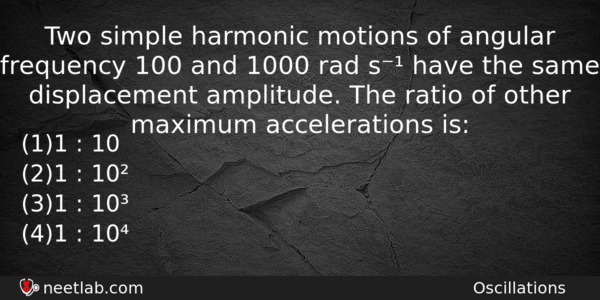| ⇦ | 
| ⇨ |
Two simple harmonic motions of angular frequency 100 and 1000 rad s⁻¹ have the same displacement amplitude. The ratio of other maximum accelerations is:
Options
(a) 1 : 10
(b) 1 : 10²
(c) 1 : 10³
(d) 1 : 10⁴
Correct Answer:
1 : 10²
Explanation:
Maximum acceleration of a particle in the simple harmonic motion is directly proportional to the square of angular frequency i.e., a(max)= – w ² A
As A remains same, we can say
a₁ / a₂ = w₁² / w₂² = (100)² / (1000)² = 1 / 100
⇒ a₁ : a₂ = 1 : 10²
Related Questions: - Angular momentum of the particle rotating with a central force is constant due to
- In which of the following systems will the radius of the first orbit (n=1) be minimum?
- The speed of light in media M₁ and M₂ are 1.5×10⁸ ms⁻¹ and 2×10⁸ ms⁻¹ respectively.
- A plumb line is suspended form a ceiling of a car moving with horizontal acceleration
- B is doped in Si or Ge, then we will get
Topics: Oscillations
(58)
Subject: Physics
(2479)
Important MCQs Based on Medical Entrance Examinations To Improve Your NEET Score
- Angular momentum of the particle rotating with a central force is constant due to
- In which of the following systems will the radius of the first orbit (n=1) be minimum?
- The speed of light in media M₁ and M₂ are 1.5×10⁸ ms⁻¹ and 2×10⁸ ms⁻¹ respectively.
- A plumb line is suspended form a ceiling of a car moving with horizontal acceleration
- B is doped in Si or Ge, then we will get
Topics: Oscillations (58)
Subject: Physics (2479)
Important MCQs Based on Medical Entrance Examinations To Improve Your NEET Score
18000+ students are using NEETLab to improve their score. What about you?
Solve Previous Year MCQs, Mock Tests, Topicwise Practice Tests, Identify Weak Topics, Formula Flash cards and much more is available in NEETLab Android App to improve your NEET score.
Share this page with your friends

Leave a Reply